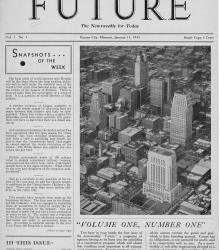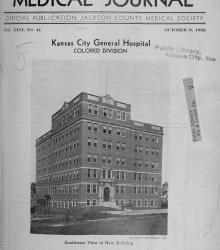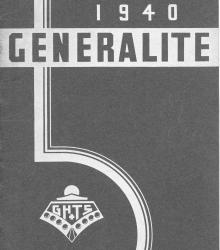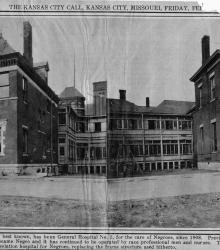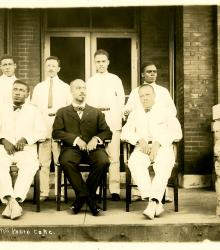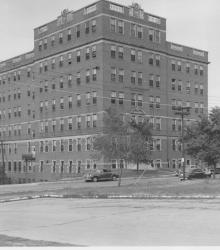First issue of the anti-corruption, Kansas City-based newspaper, Future: The Newsweekly for Today. The front page includes a statement on the newspaper's objective, maintaining that the newspaper is not against any certain political party or vice, but that it is simply for "good government".
General Hospital Number 2
This 48-page issue of the Jackson County Medical Journal focuses on the "Kansas City General Hospital: Colored Division", also known as General Hospital No. 2. Amongst advertisements for local businesses, this issue includes exterior and interior photographs of the facilities and staff.
Photograph of twelve men with medical paraphernalia labeled "Internes" at Kansas City's African-American General Hospital No. 2.
The Generalite, 1940 is a yearbook for the General Hospital Number Two, Class of 1940. Included are portraits of Dr. Edwin Henry Schorer, director of Health for Kansas City, Missouri; Dr. Percy C. Turner, Superintendent for General Hospital No. 2; Lorenda S. Harris, R. N., Superintendent of Nurses; and Miss Bernice F. Brown, R.
Photograph of General Hospital #2, a hospital for African-Americans once located just north of the intersection of 22nd Street and McCoy Avenue (now Kenwood Avenue). This vantage point faces west towards the two main wings of the hospital. Captioned: "Old City Hospital, as the above building is best known, has been General Hospital No.
Photograph of the doctors of General Hospital #2, a hospital for African-Americans once located just north of the intersection of 22nd Street and McCoy Avenue (now Kenwood Avenue). This vantage point faces west towards the southeastern entrance to the hospital.
"They did not try to build something ‘good enough for Negroes’ but something as good as money could buy." This is how Chester Arthur Franklin, the Republican founder of The Call newspaper and one of Kansas City’s most prominent black leaders, greeted the newly constructed eight-story building that housed General Hospital No. 2, serving the indigent African American population of Kansas City.
